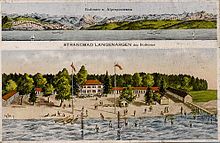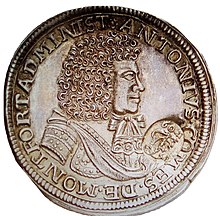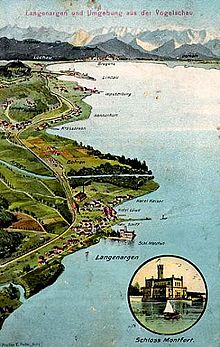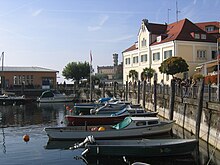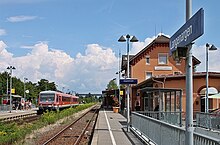Langenargen
| coat of arms | Germany map | |
|---|---|---|
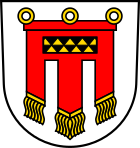
|
Coordinates: 47 ° 36 ' N , 9 ° 33' E |
|
| Basic data | ||
| State : | Baden-Württemberg | |
| Administrative region : | Tübingen | |
| County : | Lake Constance district | |
| Height : | 399 m above sea level NHN | |
| Area : | 15.27 km 2 | |
| Residents: | 7721 (Dec. 31, 2018) | |
| Population density : | 506 inhabitants per km 2 | |
| Postal code : | 88085 | |
| Area code : | 07543 | |
| License plate : | FN, TT, ÜB | |
| Community key : | 08 4 35 030 | |
| LOCODE : | DE LIV | |
| Address of the municipal administration: |
Obere Seestrasse 1 88085 Langenargen |
|
| Website : | ||
| Mayor : | Achim Krafft ( CDU ) | |
| Location of the municipality of Langenargen in the Lake Constance district | ||
Langenargen is a municipality in Baden-Württemberg on the north shore of Lake Constance , about eight kilometers east of Friedrichshafen in the Lake Constance district .
location
The community lies between the mouths of the Argen and Schussen tributaries, on a headland that protrudes far into the particularly wide Lake Constance.
"Langenargen can only be compared with the most beautiful views of Genoa and Naples."
Neighboring communities
Langenargen borders Eriskirch in the west, Tettnang in the north and Kressbronn in the east . In the south, Lake Constance forms the natural border with Switzerland .
Community structure
The municipality of Langenargen includes the villages of Langenargen and Oberdorf , the hamlets of Bierkeller, Schwedi and Tuniswald, and the farms of Endringerhof and Mückle.
Protected areas
In the area of the municipality of Langenargen, the regional council of Tübingen or the Bodenseekreis district office as the lower nature conservation authority have established a nature reserve (" Argen ") and five landscape protection areas (" Argenaue Reutenen ", " Ice Age edges of the Argental with Argenaue ", " sand pits and excavation pits north and west des Bierkeller ”,“ Tettnanger Forest with Hochwacht, Krüntenbühl, Reichenbühl, Argenhardter Kopf, Schoos and the steep edge of the Argental on the Schwandenbogen ”and“ Württembergisches Bodenseeufer ”).
history
In the 1990s, Roman finds from the first and second AD centuries were made in the municipality , which led to the thesis that the place name “Ad Arguna” possibly goes back to a Roman topographical designation even without uninterrupted settlement continuity (as for example by the archaeologist Eric Breuer represented).
Langenargen was first mentioned in a document under the name "Arguna" in 773 in a deed of donation to the St. Gallen monastery . In 1193 Heinrich von Veringen was "Custos et Cellarius" of the Langenargen Church ( ecclesiae Argeninensis ). In the possession of the Counts of Montfort since 1290 , a castle and a mint were built here from 1343 . The place then functioned until the national bankruptcy in 1780 as the main (1440–1520) or secondary residence of a small state in the Holy Roman Empire of the German Nation, the county of Montfort.
Origin of the place name
When asked about the origin of the place name “Langenargen” it is often assumed that the name comes from the fact that the place extends over a considerable length on the shores of Lake Constance (e.g. Memminger: Description of the Oberamts Tettnang, Stuttgart, 1838, publisher JG Cotta'sche Buchhandlung). In the deed of foundation of the Langenargener Hospital zum Heiligen Geist from October 12, 1491, however, the place name "Zu der Lange Argen" can be found . Thomas Lirer's Swabian Chronicle of 1486 also mentions the “Castle of the Long Argo” . Both probably refer to the Argen river .
Langenargen since the 15th century
In 1440 Argen became a residence of the Montfort branch line Tettnang-Rothenfels . In order to upgrade this, Count Hugo obtained the high jurisdiction for the Argen rule, the right to build a shop and gred house on the lake, as well as the right to a weekly and fair. The conclusion of these efforts resulted in the town charter of Immenstadt , which was granted to the market town Argen by Emperor Friedrich III. on January 8, 1453 was awarded. This privilege was confirmed in 1463.
There is evidence of a school in Langenargen since 1577. Anna Lohr , a local resident of Langenargen , was beheaded and burned in 1625 after a witch trial for magic damage .
In 1694 the House of Montfort founded a Capuchin monastery in Langenargen . From 1716 the hospital of the Holy Spirit was rebuilt , and from 1718 the Catholic parish church of St. Martin was rebuilt within the city moat. A previous building in the Unterdorf was demolished except for the choir.
The town and castle of the Montforters were badly destroyed in the Thirty Years War , but were later rebuilt (see Naval War on Lake Constance 1632–1648 ). The castle was expanded into a castle in the following period (late 17th century), used as a prison around 1800 and released for demolition in 1810.
In 1780 the indebted Counts of Montfort ceded their estates to Upper Austria . With the Peace of Pressburg in 1805 these fell to the Electorate of Bavaria . By the border treaty of 1810 Langenargen passed to the Kingdom of Württemberg and was subordinated to the Tettnang Oberamt . As part of the bourgeois revolution of 1848, the lifelong entitlement to municipal office was abolished. Instead, the mayor and council were elected for a limited period. The new castle, which has been preserved to this day, was built from 1861 to 1866 as the private summer palace Villa Argena for King Wilhelm I of Württemberg , who however died two years before completion. The castle was built according to the plans of the Ravensburger Oberamtsbaurat Gottlieb Pfeilsticker with an octagonal staircase and observation tower in the middle of the building. As a reminder of the counts who ruled here for almost 500 years, it was then given the name Schloss Montfort .
In 1896/97, the suspension bridge over the Argen to Kressbronn was the first cable suspension bridge in Germany. Two years later, Langenargen was connected to the rail network of the Württemberg State Railways and the neighboring Bavarian State Railways via the Friedrichshafen – Lindau railway line .
Langenargen in the 20th century
41 Langenargener died in the First World War. The November Revolution in late autumn 1918, the end of the monarchy that came with it, and the new democratic state structures led to profound social upheavals in Langenargen as well. For the first time, all men and women over the age of 20 were eligible to vote; in 1922, Anna Kling ( MSPD ), a woman, entered the Langenargen municipal council for the first time.
From the spring of 1933, the democratic structures were dissolved again in the course of the National Socialist takeover, and all public life was subordinated to the Nazi system. In 1937, the annexation of the eastern part of the previously independent municipality Oberndorf to Langenargen to give more space for development. The administrative reform during the Nazi era in Württemberg led in 1938 to membership of the Friedrichshafen district , which continued to exist as the Tettnang district after the war. In the Second World War, a total of 168 residents of the community were killed, another 34 remained missing. Langenargen had been in the French occupation zone since 1945 and thus came to the newly founded state of Württemberg-Hohenzollern , which was incorporated into the state of Baden-Württemberg in 1952. In the decades after the war, public life in Langenargen was shaped by the French occupying power, which was strongly represented in the area; until 1986 the 2nd Escadron of the 13th Dragoon Paratrooper Regiment was housed here.
In 1960, Montfort Castle finally came into the possession of the municipality. The sea frost of 1963, when the entire area of Lake Constance froze over, developed into a gigantic natural spectacle and a connecting element between the states bordering Lake Constance.
In 1970 the municipality of Langenargen commemorated its first documentary mention with glamorous celebrations 1200 years ago. Due to the district reform in Baden-Württemberg , Langenargen became part of the Lake Constance district in 1973 . In 1976, the Association for the Promotion and Care of Art set up a museum in the former baroque rectory on the market square, which has since enjoyed nationwide fame. In the summer of 1993, two prominent guests paid their respects to the Lake Constance community: Federal Chancellor Helmut Kohl and the French President Mitterrand visited Langenargen and signed the Golden Book .
After the Whitsun flood in 1999 , a flood of the century , large parts of Langenargen's residential areas near the lake remained flooded for weeks.
Development of the municipality area
Population development
At the end of the 19th century there was a population decline due to the purely agrarian economic structure, which increasingly affected the district of Oberdorf. From 1890 this downward trend was stopped by an upswing in the trade and industry. Since then, a steadily growing population has been recorded to this day.
Population development in Langenargen

In the early 20th century, population growth was due to a high birth rate, but also to strong immigration, which was based on improved transport connections and the industrialization of the entire Lake Constance region. The global economic crisis of 1929 caused population growth to shrink by an average of 1.1 percent between 1925 and 1933. As a result of the settlement of armaments factories in Friedrichshafen, the population increased by almost 25 percent between 1933 and 1939. The Second World War also had an impact on Langenargen, which was mainly reflected in the proportion of the male population. In the 1950s, the population continued to grow due to the influx of displaced persons. There was also an increase in immigrants during the years of the economic miracle . In the early 1990s, Langenargen's population benefited significantly from the fall of the Iron Curtain.
Incorporations
- 1937: Oberdorf
Religious affiliation
| religion | Percentage ownership % | ||
|---|---|---|---|
| 1910 | 1987 | 2016 | |
| Catholic | 90.1 | 64.5 | 48.7 |
| evangelical | 9.9 | 26.1 | 21.7 |
| other / none | 0 | 9.4 | 29.7 |
politics
Administrative association
Langenargen forms a community administration association with Kressbronn and Eriskirch , which is based in Kressbronn.
Municipal council
After the local elections on May 26, 2019 , the distribution of seats was as follows:
| Party / list | Share of votes | +/-% p | Seats | +/- |
| FWV | 33.7% | - 0.8 | 6 seats | ± 0 |
| CDU | 26.1% | - 7.7 | 5 seats | - 1 |
| SPD | 9.4% | - 8.5 | 2 seats | - 1 |
| GREEN | 30.8% | + 16.2 | 5 seats | + 2 |
coat of arms
A three-lobed red flag with gold tassels and rings as well as a gold-black interior decoration on a silver background. The community received permission on September 15, 1899 to use this coat of arms. It is the modified shield of the former coat of arms of the Counts of Montfort , a branch line of the Count Palatine of Tübingen .
Mayor and mayor
- before 1494: Franz
- at 15 ??: Eglin
- around 1520: Achill Werle
- 1526: Sebastian Stoppel
- 1557/1574: Nikolaus Paumann (Baumann)
- 1580: Martin Giger (violinist)
- 1590: Thoman Yelin (Jehle)
- around 1600: Christoph Wocher, called "the elder"
- 1614: Hans Mayr
- 1624: Jakob Yelin (Jehle)
- 1638: Kuenlin
- 1640: Stübler
- 1642: Christoph Wocher, nephew of Christoph Wocher the Elder. Ä.
- 1656–1664: Georg Brugger
- 1665–1709: Leonhard Zwicklin
- 1709-1726: Nueber
- 1726–17 ??: Jakob Bachmann
- 17 ?? - 1756: Johann G. Bernhard
- 1756–1788: Anton Berger
- 1788–1799: Jakob Bernhard
- 1800–1812: Severin Schnell
- 1814: Gagg
- 1816: Johann Baptist Wocher
- 1819–1843: Ignaz Streicher
- 1843: Ottmar Wagner
- 1844–1849: Johann Gottlieb Hutten (1848/49 also member of the state parliament of the parl. Left, 1852 emigrated to the USA)
- 1849–1852: Josef Meschenmoser (clerk)
- 1852–1853: Johann Nepomuk Bleyle (clerk)
- 1853–1854: Josef Schmeckenbecher
- 1854–1860: Lorenz Konrad
- 1860–1870: Anton Fuchsschwanz
- 1870–1874: Albert Schilling (also an important local chronicler)
- 1874–1888: Franz Xaver Gläsle
- 1891–1907: August Friker, Center Party
- 1907–1931: Franz Xaver Mayr, Center Party
- 1931–1937: Anton Philipp Herter, independent
- 1937–1945: Oskar Hess, NSDAP
- 1945–1954: Alfred Wocher, CDU
- 1954–1974: Franz Eble, CDU
- 1974–1982: Lothar Grothe, CDU
- 1982–2012: Rolf Müller, CDU
- since 2013: Achim Krafft, CDU
City partnerships and sponsorships
-
 Bois-le-Roi , since 1991
Bois-le-Roi , since 1991 -
 Noli , since 2005
Noli , since 2005 -
 Arbon on the opposite shore of the lake, since 1963
Arbon on the opposite shore of the lake, since 1963 -
 Höckendorf , Saxony , since 1990
Höckendorf , Saxony , since 1990 - 3ème Régiment de Hussards, 1st Escadron, Immendingen , since 2000
- Airborne Medical Company (SpezEins), 4th / Airborne Support Battalion 262 , Merzig , since 2003
Culture and sights
Museums
Local history museum in the old rectory: Here art from Langenargen, the county of Montfort and the wider region is shown. The collection includes paintings, sculptures and coins from the Romanesque to the present day. The exhibited artists include Franz Anton Maulbertsch , Andreas Brugger , Karl Caspar , Hilde Broër , André Ficus , Berthold Müller-Oerlinghausen , Jan Balet , Marcel Dornier and Julius Herburger . After the Purrmann House in Speyer, the museum has the second largest public collection of Hans Purrmann's works in Germany. Purrmann (1880–1966) was a German painter and graphic artist of classical modernism.
Buildings
Langenargen is located on the southern route of the Upper Swabian Baroque Route .
- Montfort Castle : The landmark of the community of Langenargen, built 1861–1866 under the name “Villa Argena”, was intended to serve as a pleasure palace for Wilhelm I of Württemberg and his heir to the throne Karl. The oriental construction served as an architectural model, numerous Moorish architectural features are appropriate. The castle was built on a headland on the site of the ruins of the Argen moated castle . The former peninsula was fortified by the castle of the Counts of Montfort since the Middle Ages.
- Kavalierhaus Langenargen , built in 1866 to complement Montfort Castle
- Hospital to the Holy Spirit
- Grain and warehouse at the community port, the building now houses the customs house
- Montfortisches Amtshaus
- Suspension bridge over the Argen , the cable suspension bridge built by Karl von Leibbrand under King Wilhelm II from 1896–1897 spans the Argen between Langenargen and Kressbronn; the third oldest suspension bridge in Germany has a span of 72 meters.
Churches and chapels
- St. Martin (Langenargen) , from 1718 to 1721 under Count Anton III. built by Montfort and his wife Countess Maria Anna von Thun and Hohenstein and consecrated in 1722, church tower and rectory built by Count Ernst von Montfort († 1780) in 1735; Together with the adjoining Spital Zum Heiligen Geist , today's old people's home, the ensemble of buildings has a major impact on the market square as the historic center of Langenargen; in 1728 the Marienkapelle was added to the church
- Parish Church of St. Wendelin in Oberdorf (built in 1827)
- St. Anna cemetery chapel in Langenargen, the Romanesque choir of the demolished former St. Martin's Church was consecrated in 1722
- Evangelical Peace Church, founded in 1912 by Heinrich and Alfred Weiß; the latter was a direct maternal descendant of the reformer Martin Luther . It was consecrated in December 1914. The church forms an architectural unit with the parish hall and rectory. In the 1960s, the church was renovated and the Art Nouveau design was removed. In the course of this, the naming took place. Since 2001 a window commemorates the reformer Urbanus Rhegius from Langenargen . The beams of the crucifix, which has been redesigned since 2014, come from the war-damaged Schlosskirche Friedrichshafen , while the body comes from the Art Nouveau church.
- New Apostolic Church
Other
- Center for Buddhism and Thai Culture-Bodensee e. V .: In 2010 the Thai community inaugurated the Center for Buddhism and Thai Culture Lake Constance with a Buddhist temple and has held regular events there since then.
BMK marina
The marina with around 750 berths is the second largest on Lake Constance.
Large and small harbor crane
There are two historic harbor cranes at the port of Langenargen. The large harbor crane was built around 1900 and restored in 2006, the small harbor crane dates from 1909 and was restored in 2005. You have been named " Monument of the Month December 2005" by the Monument Foundation Baden-Württemberg .
At the Langenargener Hafen, the change in meaning from cargo shipping to leisure shipping is clearly visible. The landing stage for goods shipping developed into a relatively important trading port at times, lost this position almost completely and, with the rise of tourism, gained new importance as a leisure marina. Its function as the home of many professional fishermen has been preserved to this day.
Sculptures and objects
Regular events
- Münzhof: Langenargen event center, cabaret and library
- Langenargener Palace Concerts: Classical, Jazz and Crossover in "Schloss Montfort"
- Langenargener Festival - summer theater on Lake Constance
- Sailing regatta "Match Race Germany"
- Bank party with impressive fireworks and traditional " Fischerstechen "
- Kavalierhaus: producers' gallery
- Promenade concert and other appearances in the concert shell
- Christmas market in the "Städtle"
- Carnival tradition with a big fool's jump
- International soccer A-Juniors tournament over Pentecost
economy
Agriculture, especially fruit growing , still plays a certain role in Langenargen, mainly in the rural suburb of Oberdorf.
Otherwise, the community now lives mainly from tourism as well as from handicrafts and small to medium-sized businesses . As a 'discoverer' of Langenargen for tourism applies Annette von Droste-Hulshoff , who immortalized their site visit in 1842 literary ". Do not miss yes Langenargen" mid-19th century began the systematic development of the tourist infrastructure, currently has Langenargen per Around 250,000 overnight stays a year. In the long term, the expansion of the commercial structure is planned through appropriate economic development measures.
The energy supply is provided by the regional plant in Lake Constance . In the Langenargen fish hatchery, fish from Lake Constance are hatched and used in the Baden-Württemberg part of Lake Constance.
Infrastructure
traffic
Langenargen is three kilometers south of the federal highway 31 between Friedrichshafen and Lindau .
The community is served by Deutsche Bahn AG on the Friedrichshafen – Lindau railway line and can be reached from the lake using the Bodensee shipping company lines. It belongs to the Bodensee-Oberschwaben Verkehrsverbund (bodo). Langenargen can be reached by bus via line 224 (Strauss Reisen) from Tettnang and line 7587 ( RAB ) from Friedrichshafen.
As a municipality located directly on the lake, Langenargen is also the station of the Lake Constance cycle path and the Lake Constance circular path .
Since Whitsun 2011, the so-called FUN (K) -Bähnle has been commuting between Langenargen and Kressbronn. It carries up to thirty people up to six times a day. There are five stops on Langenargener and four on Kressbronn municipality.
Authorities
On Malereck is located Institute of Lake Research .
Educational institutions
schools
- Primary school Franz-Anton-Maulbertsch -Schule
- Primary school Oberdorf
Kindergartens
- Evangelical kindergarten
- Catholic kindergarten St. Elisabeth, Langenargen
- Catholic kindergarten St. Theresia, Oberdorf
- Community kindergarten, Bierkeller-Waldeck
- Child care and parents' meeting Rumpelstilzchen e. V.
- Lake and forest kindergarten Langenargen
Leisure and sports facilities, public facilities
- Lido with heated outdoor pool and children's fun pool with water slide (open from mid-May to mid-September)
- Langenargen swimming pool (closed from the beginning of April to the end of September)
- sport Center
- Youth music school
- Senior meeting place
- Community archive with local history specialist library
- Stellwerk youth club
- Library in the Münzhof
Personalities
Honorary citizen
- 1844, Peter Joseph von Lindpaintner (1791–1856), conductor and composer
- 1907, August Friker (1862–1923), mayor from 1891 to 1907.
- 1955, Albert Schöllhammer (1875–1960), head gardener, councilor ( DVP )
- 1955, Eugen Kauffmann (1882–1972), entrepreneur and councilor
- 2001, Eduard Hindelang (1923–2016), chairman of the museum association
sons and daughters of the town
- Urban Rieger, called Urbanus Rhegius (1489–1541), reformer
- Moritz Thomann SJ (1722–1805), missionary in Asia and Africa
- Franz Anton Maulbertsch (1724–1796), Austrian painter of the late Baroque period
- Joseph Reebmann (1730–1812), from 1782 curate chaplain of Ratzenried in the diocese of Constance, professor of theology at the University of Freiburg im Breisgau
- Joseph Anton Gagg (1797–1887), senior teacher, honorary citizen of Friedrichshafen
- Fridolin Schneider (1850–1922), educator and politician ( center ), member of the Reichstag
- Johannes Baptist von Kiene (1852–1919), lawyer and politician ( center ), Minister of Transport and Justice of Württemberg 1918/1919
- Heinrich Hauber (1904–1983), painter
- Christoph Wocher (* 1924), lawyer, board member of Wüstenrot Holding and the building society until 1989.
- Josef Christ (* 1956), judge at the Federal Administrative Court
- Bruno Kurz (* 1957), painter and installation artist
Other personalities
- Achilles Pirminius Gasser (1505–1577), historian, physician and astrologer, spent part of his youth in Langenargen
- Anton III von Montfort (1670–1733), was Count of Tettnang and Langenargen
- Andreas Brugger (1737–1812), an important oil and fresco painter who was born in Kressbronn and later resident in Langenargen
- Franz Joseph Salwohl (1762–1820), coin engraver who grew up in Langenargen and worked at the Milan Mint
- Franz Anton Kiene (1777–1847), organ builder, based in Langenargen since 1828
- Princess Luise Marie of Prussia (1829–1901) bought Montfort Castle in 1873 as a summer residence
- Wilhelm Olivier von Leube (1842–1922), university professor and rector of the Julius Maximilians University of Würzburg , owner of Montfort Castle from 1902
- Erich Schultz-Ewerth (1870–1935), lawyer, Privy Councilor, last Imperial Governor of German Samoa (1912–1919), resident in Langenargen in the 1920s
- Wilhelm Bleyle (1850–1915), founder of the Bleyle textile company , from a family resident in Langenargen since 1661
- Hans Purrmann (1880–1966), painter, resided in Langenargen from 1919 to 1935 and buried there
- Reinhard Demoll (1882–1960), zoologist and university professor, initiator of the Langenargen Institute for Lake Research and Lake Management
- Alfred Radlayers (1885–1973), professor, reform pedagogue, 1912 founder and director of the "Württemberg Landerziehungsheim Langenargen"
- Jan Balet (1913–2009), painter, graphic artist and illustrator, spent part of his childhood (1916–1920) with his grandparents, the Eggert family, in Langenargen
literature
- Christoph Wocher (ed.): The history of Langenargen and the House of Montfort. Arguna, Darmstadt 1986. (New edition of Pastor Eggart's book with additions)
- Christoph Wocher (Ed.): Langenargen, its history and that of its rulers, especially the Counts of Montfort. Arguna, Darmstadt 1994 (new edition of the book by Albert Schilling)
- Christoph Wocher (Ed.): History of the Württ. Schützengilde Langenargen 1923–1945 and the Schützengilde Langenargen e. V. 1961-1985. Arguna, Darmstadt 1986.
- Christoph Wocher (Ed.): Langenargen between war and peace, history-fates. Arguna, Überlingen 1999.
- Municipality of Langenargen (ed.): Langenargener story (s). Volumes I – VIII. Senn, Tettnang 1986-1995.
- Andreas Fuchs, Christoph Wocher, Klaus-Peter Bitzer, Hermann Hauser: Langenargen 1900–1999. A communal chronology of the 20th century. Municipal administration, Langenargen 2000.
- Andreas Fuchs: Local history specialist library in the Langenargen community archive - inventory overview. Municipal administration, Langenargen 2005.
- Andreas Fuchs, P. Viktrizius Veith, P. Peter Baptist Zierler: Pax et bonum - Friede und Heil. From the history of the Capuchin monastery and Elisabethenhaus in Langenargen. Municipal administration, Langenargen 2006.
- Wolfgang Fix, Andreas Fuchs, Hermann Hauser: Seealemannisch. A Langenargener dictionary and picture book. Municipal administration, Langenargen 2008.
- Andreas Fuchs u. a .: The meaning of the street names in Langenargen and its suburbs. Municipal administration, Langenargen 2011.
- Municipality of Langenargen (ed.): Langenargen military school of the French Ecole de Cadres 1945–1950. Langenargen 2011.
- Andreas Fuchs, Bettina Countess Bernadotte: Don't miss Langenargen [Annette von Droste-Hülshoff]. On the history of tourism in Langenargen on Lake Constance. Municipal administration, Langenargen 2015.
Web links
- Internet portal of the municipality of Langenargen on Lake Constance
- Langenargen community archive with local history specialist library
Individual evidence
- ↑ State Statistical Office Baden-Württemberg - Population by nationality and gender on December 31, 2018 (CSV file) ( help on this ).
- ↑ Stiftsarchiv St. Gallen (ed.): Chartularium Sangallense. Volume I, St. Gallen 2013, p. 54 f.
- ↑ Elmar Kuhn: Langenargen - almost six centuries of rule and residence of the Counts of Montfort. In: Gemeinde Langenargen (Ed.): Annual review 2015 - Outlook 2016. Self-published, Langenargen 2016, p. 55 ff.
- ^ Johann B. Kichler: Langenargen and its history. Municipal administration, Langenargen 1911, p. 47.
- ↑ Peter Eitel: The cities of the Counts of Montfort in Upper Swabia . In: Decker-Hauff, Hansmartin, Franz Quarthal, Wilfried Setzler (eds.): The Count Palatine of Tübingen. Urban politics, Pfalzgrafenamt, aristocratic rule in Breisgau. Jan Thorbecke Verlag Sigmaringen 1981, pp. 29-38.
- ↑ Description of the Oberamt Tettnang / Chapter B 12
- ↑ Open Monument Day: Where the wheel of time turns
- ↑ Langenargen - Langenargener Festival. Retrieved October 27, 2017 .




